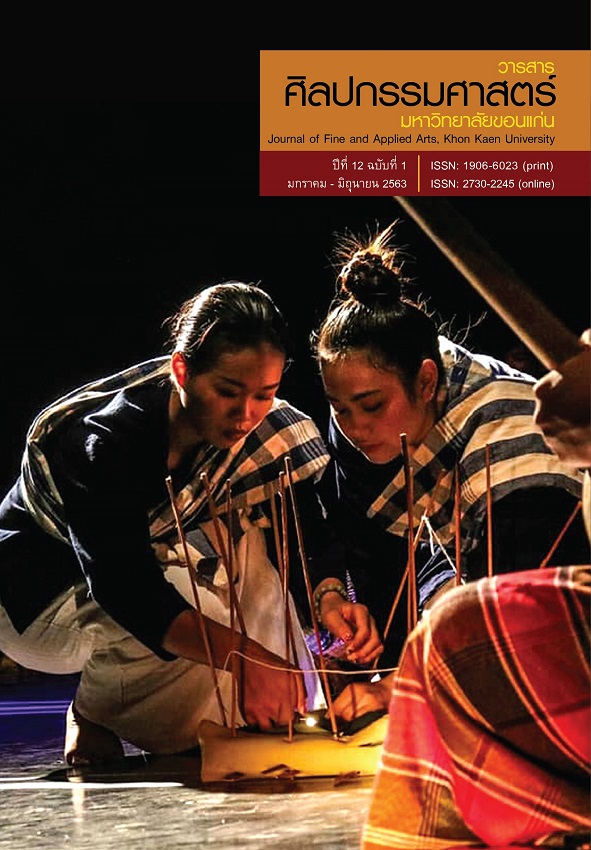Guidelines for Creating Value Added to Local Rice Products Corresponding to the Current Context and Way of Consumption of Consumers in Rasi Salai District, Sisaket Province.
Main Article Content
Abstract
The objectives of this research were: 1) to study the traditional wisdom of traditional rice production and processing, 2) to process the traditional rice responding to the present consumption, 3) to develop the package and channel for traditional rice marketing based on present consumption style, and 4) to develop the wisdom learning curriculum for traditional rice production and processing to be suitable for the context as well as congruent with the need of area. This research is a qualitative research. By using the target group selection method to collect specific data. The target group area for data collection were: 1) the experts including the local wisdom, leader, experts in production, consumption, and processing, and 2) the practitioners including the traditional rice producer and processor, teacher, student, and stakeholder with production and processing consumers in Rasi Salai District area, Sisaket Province. The research instruments were: 1) the In-depth Interview, 2) the Questionnaire, and 3) the outline of questions for the focus group
The research findings found that:
For the study in traditional wisdom of traditional rice production and processing, found that the traditional rice of consumers in Rasi Salai District area, Sisaket Province, consisted of many rice strains. Various rice strains were grown, consumed, and sold. Furthermore, there were many traditional rice producers covering many sub-districts, and production areas. Specifically, in Rasi Salai District area.
For the rice processing responding to present consumption as well as corresponding to the market need, found that according to the analysis of phytochemicals in each strain of traditional rice, found that Moreover, 12 kinds of them focusing on high level of phytochemicals as well as the rice with color and shape being congruent with the processing for consumption which could be developed for processing product being convenient, modern, and corresponding to the consumer’s need.
The development of package and channel for traditional rice based on the way of present consumption and correspondence to the market need, found that 12 kinds of traditional rice processing product
The development of curriculum for wisdom learning and traditional rice production and processing to be suitable for context and correspond to the need of area. It was the analysis of learning curriculum development for children as well as persons being interested in Rasi Salai District area, Sisaket Province, 3 curricula could be developed including.
Article Details
Content and information in articles published in the Journal of Fine and Applied Arts of Khon Kaen University is regarded as the opinion and sole responsibility of the author(s) directly; therefore, editors are not obliged to agree to or share any responsibility with regard to the content and information that appears within these articles.
All articles, information, content, image, etc. that have been published in the Journal of Fine and Applied Arts of Khon Kaen University is the copyright of the Journal of Fine and Appllied Arts of Khon Kaen University. Any person or organization who wishes to distribute all or parts of the articles for further dissemination or other usage must first receive permission from the Journal of Fine and Applied Arts of Khon Kaen University before proceeding to do so.
References
กาญจนา แก้วเทพ, และสมสุข หินวิมาน. (2551). สายธารแห่งนักคิดทฤษฎีเศรษฐศาสตร์การเมืองกับสื่อสารศึกษา. กรุงเทพฯ: ภาพพิมพ์.
กิตติพงษ์ ตระกูลโชคอำนวย. (2558). นวัตกรรมการผลิตข้าว การแปรรูปข้าว และการค้าข้าวในประเทศไทย. วารสารพัฒนาสังคม, 17(2), 51–67.
กลุ่มนาพลังธรรมชาติ. (2553). รายงานการปลูกข้าวพื้นบ้าน กลุ่มนาพลังธรรมชาติ อำเภอเสลภูมิ จังหวัดร้อยเอ็ด.
จินตนา เพชรพงศ์. (2552). ปัจจัยที่มีผลต่อพฤติกรรมการเลือกซื้อข้าวกล้องบรรจุถุงของผู้บริโภคในเขตกรุงเทพมหานคร. วิทยานิพนธ์ปริญญาบริหารธุรกิจมหาบัณฑิต สาขาวิชาการจัดการ บัณฑิตวิทยาลัย มหาวิทยาลัยศรีนครินทรวิโรฒ.
ดวงพร ภู่ผะกา. (2559). ความหลากหลายของพันธุ์ข้าวพื้นเมืองเพื่อการพัฒนาผลิตภัณฑ์เสริมอาหารและอาหารสุขภาพของจังหวัดฉะเชิงเทรา. วารสารวิทยาศาสตร์ มข., 44(3), 566–578.
ดาวเรือง พืชผล และคณะ. (2551). การศึกษาพันธุกรรมข้าวพื้นบ้านเพื่อการขยายผลผลิตข้าวในระบบเกษตรกรรมยั่งยืนในพื้นที่บ้านกุดหิน บ้านกำแมด บ้านโนนยาง ตำบลกำแมด อำเภอกุดชุม จังหวัดยโสธร. กรุงเทพฯ: สำนักงานกองทุนสนับสนุนการวิจัย.
นันทิยา พนมจันทร์, และวิจิตรา อมรวิริยะชัย. (2554). ความหลากหลายทางพันธุกรรมของข้าวพื้นเมืองบริเวณลุ่มน้ำทะเลน้อย จังหวัดพัทลุง โดยใช้ลักษณะทางสัณฐานวิทยาของเมล็ด. วารสารหาดใหญ่วิชาการ, 9, 25-31.
แผนงานฐานทรัพยากรอาหาร สำนักงานกองทุนสนับสนุนการสร้างเสริมสุขภาพ. (2551). มหัศจรรย์พันธุ์ข้าวพื้นบ้าน: คุณค่าทางโภชนาการของสายพันธุ์ข้าวท้องถิ่น. ค้นเมื่อ 20 มิถุนายน 2553, จาก https://prachatai.com/journal/2008/09/18027
พัชรี ตั้งตระกูล. (2555). การแปรรูปข้าวเพื่อสร้างมูลค่าเพิ่ม. เอกสารประกอบการประชุมวิชาการข้าวแห่งชาติ ครั้งที่ 2 มิติใหม่วิจัยข้าวไทยพร้อมรับการเปลี่ยนแปลงของสภาพภูมิอากาศและการเปิดตลาดเสรีอาเซียน, กรุงเทพฯ, สำนักงานพัฒนาวิทยาศาสตร์และเทคโนโลยีแห่งชาติ.
รัชนี คงคาฉุยฉาย และคณะ. (2551). ปริมาณ ธาตุเหล็ก สังกะสี ธาตุทองแดง วิตามินอี เบต้าแคโรทีน และลูทีน ในข้าวพันธุ์พื้นเมืองจากแหล่งต่างๆ ของประเทศไทย. วารสารสำนักงานคณะกรรมการวิจัยแห่งชาติ (วิทยาศาสตร์), 4(2), 13-32.
วรินทร์พร กลั่นกลิ่น และคณะ. (2555). คุณค่าทางโภชนาการของข้าวก่ำต่อสุขภาพ. พยาบาลสาร, 39, 128-139.
วีรฉัตร์ สุปัญโญ, วรรณี อึ้งสิทธิพูนพร, จักษณา อธิรัตน์ปัญญา, และคณะ. (2555). การพัฒนาหลักสูตรชุมชน เรื่องข้าว สำหรับเยาวชนบ้านดอนเตามอิฐ. ใน การประชุมวิชาการเกษตรกำแพงแสน ครั้งที่ 9 สาขาศึกษาศาสตร์และพัฒนศาสตร์ ธันวาคม 2555. (หน้า 1654-1663). กรุงเทพฯ: คณะศึกษาศาสตร์และพัฒนศาสตร์ มหาวิทยาลัยเกษตรศาสตร์.
สิริการ หนูสิงห์, ปาจารีย์มันดี, และบุศราภา ลีละวัฒน์. (2557). การพัฒนาชาข้าวก่าเพาะงอกพร้อมชง. วารสารวิทยาศาสตร์และเทคโนโลยี, 22(3), 337-346.
สุนันท์ วิทิตสิริ. (2559). ผลิตภัณฑ์จากข้าวไทยและผลพลอยได้ที่น่าสนใจ. กรุงเทพฯ: โอ เอส พริ้นติ้ง เฮาส์.
สุภางค์ จันทวานิช. (2546). การวิเคราะห์ข้อมูลในการวิจัยเชิงคุณภาพ. พิมพ์ครั้งที่ 5. กรุงเทพฯ: สำนักพิมพ์แห่งจุฬาลงกรณ์มหาวิทยาลัย.
Denzin N.K. (1970). The research act: A theoretical introduction to sociological methods. Chicago: Aldine.


